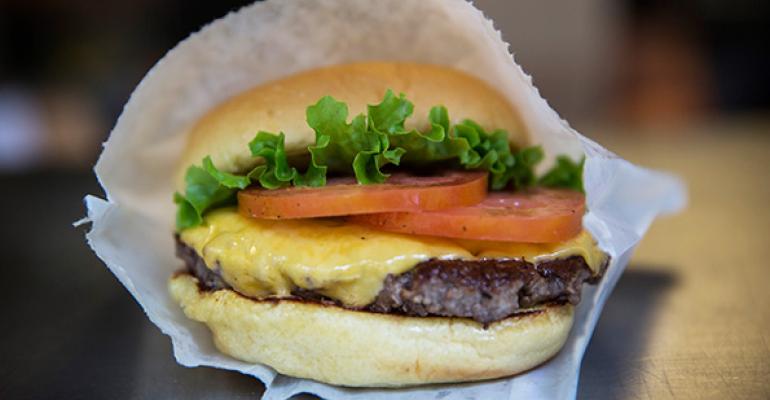Shake Shack Inc. is raising the starting pay at its four Washington, D.C., area restaurants to $12 an hour as part of a strategy to stay ahead of rising minimum wages in many communities.
“As we look at minimum wages, we are going to stay proactive with our compensation practices, recruiting and with the development of our team,” Shake Shack CFO Jeff Uttz said during the company’s second-quarter earnings call Monday. “Taking care of our team members first will always drive our decision making.”
Executives said they expect to be able to handle increases in the minimum wage in New York, where many of Shake Shack’s restaurants are located and where the governor there has mandated an increase in the minimum wage to $15 at quick-service restaurants.
Shake Shack raised menu prices by 6 percent in recent quarters, in two separate price increases last year and this year, CEO Randy Garutti said, and yet traffic in the second quarter ended July 1 increased 4.3 percent.
“The first labor increase will come in December,” Garutti said. “There’s no doubt it can take a toll on the entire industry. We’ve always paid above minimum wage and we’re well-positioned to increase that as we need to.”
Minimum wages are rising in many states and communities, and Washington, D.C., is expected to vote on a $15 minimum wage next year. The higher wages are expected to have a significant impact on restaurant chains, which tend to have a high number of low-wage workers.
Shake Shack executives warned repeatedly that labor costs as a percentage of revenue would increase over time, both because of labor cost increases and because new units are expected to have lower volumes.
Shake Shack locations in the second quarter averaged $102,000 in sales per week, which translates into $5.3 million for a full year. But over time, the company expects average unit volumes of about $2.8 million to $3.2 million as it opens more locations outside of its hometown of New York.
That should drive labor costs higher. Shake Shack’s labor costs were 24 percent of revenues in the second quarter, a decrease of 150 basis points and well below the 30 percent target for many limited-service concepts. Executives expect the percentage to increase as labor costs keep rising and as unit volumes shrink, thereby reducing labor productivity within the restaurants.
Shake Shack is increasing its projections for unit growth. The company has long said that it expects to add about 10 units a year, but this year expects to add 12 locations, and now expects to add 12 units a year for the foreseeable future.
That includes locations in Austin, Texas, Chicago and New Jersey. The company plans to move into Los Angeles and Arizona next year.
“Our development plans through 2016 look strong, and we are well-positioned to capitalize on our brand strength to secure premium sites in dynamic locations across the country,” Garutti said.
He added that the company’s January IPO and its growing popularity might be helping get the word out to developers and landlords, enabling the company to increase its development.
“Our development team is out there, hitting the road and doing a great job,” Garutti said. “There is no question there are a lot of developers out there and landlords who understand our story more than ever, due to the IPO and given the increase in geographic reach of Shake Shack.”
Executives also insisted that its same-store sales strength in the first half of the year is not sustainable over the long term, particularly given that many locations are operating at high unit volumes. The company expects same-store sales to be in the low single digits long-term.
“We just don’t believe that a 12.9-percent (same-store sales) is sustainable,” Uttz said.
Another area where Shake Shack is cautious is food costs. The company’s food and paper costs were 29.4 percent of revenues in the second quarter, a decrease of 110 basis points, due largely to menu price increases. Higher beef costs continue to hurt the company, but have been offset by lower dairy costs.
The company is also monitoring the impact of avian flu on the price of eggs, a key ingredient in its frozen custard, used in its shakes.
Shake Shack tested a ChickenShack sandwich in the second quarter in three restaurants and ran out of supply in just two days before returning the sandwich to those locations, in Brooklyn, N.Y.
Customer feedback “has been amazing,” Garutti said.
“You do a search on Instagram for ChickenShack and you’ll get many thousands of posts of people having a good time and loving it,” he said. “So it is an interesting thing for us to watch.”
He added that the company will learn from the test and what it means for its menu, and “we will keep you all posted on what we may or may not do with chicken down the road.”
Contact Jonathan Maze at [email protected].
Follow him on Twitter: @jonathanmaze




